Subscribe to our ▶️ YouTube channel 🔴 for the latest videos, updates, and tips.
Division of Four-Digit by a One-Digit Numbers
In division of four-digit by a one-digit numbers are discussed here step by step.
How to divide 4-digit numbers by single-digit numbers?
Let us follow the examples to learn to divide 4-digit numbers by one-digit numbers.
Divide and find the quotient:
(i) 3408 ÷ 3
(ii) 6585 ÷ 5
(iii) 4107 ÷ 6
(iv) 7608 ÷ 8
Solution:
The same procedure will be adopted to divide a 4-digit number by a single digit number.
(i) 3408 ÷ 3
3 x 1Th = 3Th, 1Th is the quotient
3 x 1H = 3H, 3 x 2H = 6H, 1H is the quotient
3 × 3T = 9T, 3 x 4T = 12T, 3T is the quotient
3 × 6 = 18, 6 is the quotient
Verification
3 × 1136 + 0 = 3408 + 0 = 3408
So, result is verified.
Quotient = 1136
or,
Instead of 3000, we put 3
Instead of 300, we put 3
Instead of 90 we put 9
(ii) 6585 ÷ 5
(i) 5 × 1Th = 5Th. 1Th is quotient
6Th - 5Th = 1Th
(ii) 5 × 3H = 15H, 3 H is quotient
(iii) 5 × 1T = 5T, 1T is quotient
(iv) 8T - 5T = 3T, 5 is carried down
5 × 7 = 35, 7 will be quotient
Quotient = 1317
Verification = 5 × 1317 + 0 = 6585 + 0 = 6585.
Result is verified.
(iii) 4107 ÷ 6
Quotient = 684 Remainder = 3
(i) 4 < 6, So, 41 is taken for division
6 × 6 = 36, 6 × 7 = 42,
6H will be quotient.
(ii) 50 is taken for division
6 × 8 = 48, 6 x 9 = 54,
8T is the quotient.
(iii) 27 is taken for division
6 × 4 = 24, 6 × 5 = 30
Therefore, 4 is the quotient.
Verification = 6 × 684 + 3 = 4104 + 3 = 4107.
So, result is verified.
(iv) 7608 ÷ 8
Quotient = 951 Remainder = 0
(i) 7 < 8, So 76 is taken for division
8 × 9 = 72, 8 × 10 = 80
9H is quotient.
(ii) 76 - 72 = 4,
40 T is taken for division, 8 × 5 = 40
5T is quotient.
(iii) 08 is taken for division
8 × 1 = 8, 8 × 2 = 16,
1 is quotient.
Verification = 8 × 951 + 0 = 7608 + 0 = 7608.
Result is verified.
(v) 9575 ÷ 5
Check:
quotient × divisor = dividend
1915 × 5 = 9575
(vi) 74768 ÷ 7
Check:
quotient × divisor + remainder = dividend
1681 × 7 + 1 = 74768
4-Digit by 1-Digit Long Division Video
Subscribe to our ▶️ YouTube channel 🔴 for the latest videos, updates, and tips.
Worksheet on Division of 4-Digit by a 1-Digit Numbers:
1. Divide and find the quotient.
(i) 3,561 ÷ 2
(ii) 4,123 ÷ 3
(iii) 8,303 ÷ 5
(iv) 1,954 ÷ 7
(v) 7,050 ÷ 8
(vi) 8,754 ÷ 9
(vii) 4,327 ÷ 5
(viii) 3,510 ÷ 4
(ix) 4,160 ÷ 8
(x) 8,004 ÷ 6
(xi) 4,716 ÷ 9
(xii) 5,520 ÷ 4
Answer:
1. (i) Quotient: 1780 ; Remainder: 1
(ii) Quotient: 1374 ; Remainder: 1
(iii) Quotient: 1660 ; Remainder: 3
(iv) Quotient: 279 ; Remainder: 1
(v) Quotient: 881 ; Remainder: 2
(vi) Quotient: 972 ; Remainder: 6
(vii) Quotient: 865 ; Remainder: 2
(viii) Quotient: 877 ; Remainder: 2
(ix) Quotient: 520 ; Remainder: 0
(x) Quotient: 1334 ; Remainder: 0
(xi) Quotient: 520 ; Remainder: 0
(xii) Quotient: 1380 ; Remainder: 0
2. Find the quotient and the remainder. Also, check your answer.
(i) 3,504 ÷ 2
(ii) 1,352 ÷ 8
(iii) 2,316 ÷ 6
(iv) 7,626 ÷ 6
(v) 2,742 ÷ 6
(vi) 8,676 ÷ 4
(vii) 5,448 ÷ 8
(viii) 5,600 ÷ 7
Answer:
2. (i) Quotient: 1752 ; Remainder: 0
(ii) Quotient: 169 ; Remainder: 0
(iii) Quotient: 386 ; Remainder: 0
(iv) Quotient: 1271 ; Remainder: 0
(v) Quotient: 457 ; Remainder: 0
(vi) Quotient: 2169 ; Remainder: 0
(vii) Quotient: 681 ; Remainder: 0
(viii) Quotient: 800 ; Remainder: 0
Related Concept
● Addition
● Check for Subtraction and Addition
● Word Problems Involving Addition and Subtraction
● Estimating Sums and Differences
● Multiply a Number by a 2-Digit Number
● Multiplication of a Number by a 3-Digit Number
● Word Problems on Multiplication
● Division of Two-Digit by a One-Digit Numbers
● Division of Four-Digit by a One-Digit Numbers
● Division by 10 and 100 and 1000
● Division by Two-Digit Numbers
4th Grade Math Activities
From Division of Four-Digit by a One-Digit Numbers to HOME PAGE
Didn't find what you were looking for? Or want to know more information about Math Only Math. Use this Google Search to find what you need.
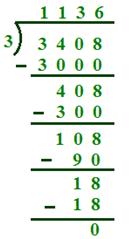
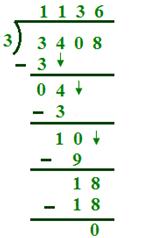
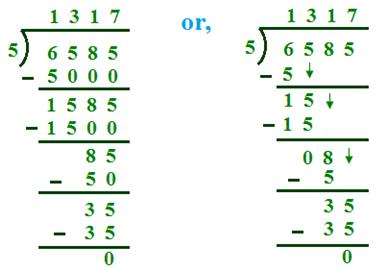
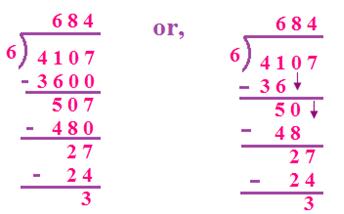
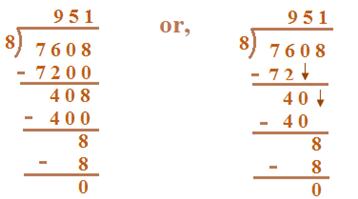




New! Comments
Have your say about what you just read! Leave me a comment in the box below. Ask a Question or Answer a Question.